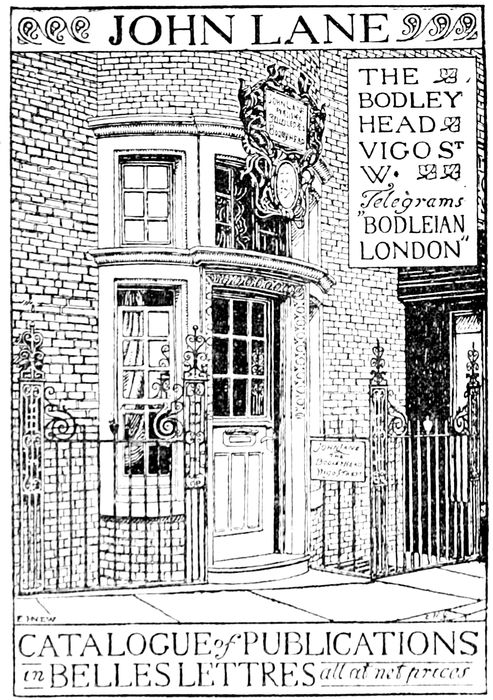In writing about the British publishing scene in the 1890s, I arrive time and again at the doorstep of no. 9 Vigo Street, the premises of John Lane and Elkin Mathews’ Bodley Head. In 1887, Lane had been at an exhibition at the Rembrandt Head Gallery in Vigo Street and had asked the owner, a Mr Dunthorne, whether he knew of a ‘cosy little corner’ out of which he could sell his books. Dunthorne gladly showed him to a small shop a few doors down where the Rembrandt Head had originally begun life. Lane made an offer on the spot, and switched ‘Bodley’ for Rembrandt. ‘Bodley, the most pious of founders!’ Lane later explained his choice. ‘Who could so fittingly be enshrined as a patron?’ Thomas Bodley had of course been the founder of the Bodleian Library in Oxford, and, like Lane, had come from Devon.
 The illustration above is by the English artist Edmund Hort New (1871-1931), who worked with Lane on new editions of classics such as The Compleat Angler and The Natural History of Selbourne. New’s Arts and Crafts style and his preference for sequestered, unpopulated scenes gives his cover for the Bodley Head’s catalogue, which he drew while staying with Lane in July 1895, a quaint and respectable appeal. It is like something out of a children’s book with its neat brickwork, the doorway built snugly under its curved lintel, and the famous Sign of the Bodley Head hanging proudly over the dark glass. To think that this is the place that published The Yellow Book, Oscar Wilde’s Salomé, and books by Arthur Machen, M. P. Shiel and Aubrey Beardsley, all of which were attacked at one point or another by the philistine press for moral indecency.
The illustration above is by the English artist Edmund Hort New (1871-1931), who worked with Lane on new editions of classics such as The Compleat Angler and The Natural History of Selbourne. New’s Arts and Crafts style and his preference for sequestered, unpopulated scenes gives his cover for the Bodley Head’s catalogue, which he drew while staying with Lane in July 1895, a quaint and respectable appeal. It is like something out of a children’s book with its neat brickwork, the doorway built snugly under its curved lintel, and the famous Sign of the Bodley Head hanging proudly over the dark glass. To think that this is the place that published The Yellow Book, Oscar Wilde’s Salomé, and books by Arthur Machen, M. P. Shiel and Aubrey Beardsley, all of which were attacked at one point or another by the philistine press for moral indecency.
The myth of Vigo Street comes down to pitched stones and shattered glass. After Wilde’s arrest in April 1895 a small riot was said to have taken place outside the shop. It was the the writer J. Lewis May who originated the rumour in his John Lane and the Nineties, published in 1936: ‘They threw stones at John Lane’s windows, and clamoured for the head of Bodley on a charger’. But no evidence has ever been produced to support this, no newspaper headlines, as Simon Casmir Wilson notes in The Wildean (January 2021). But whatever the case, Lane must have been glad of New’s catalogue illustration following Wilde’s sentencing and the denouncement of all things avant-garde – an image of the Bodley Head reborn, unattached to its decadent past.
